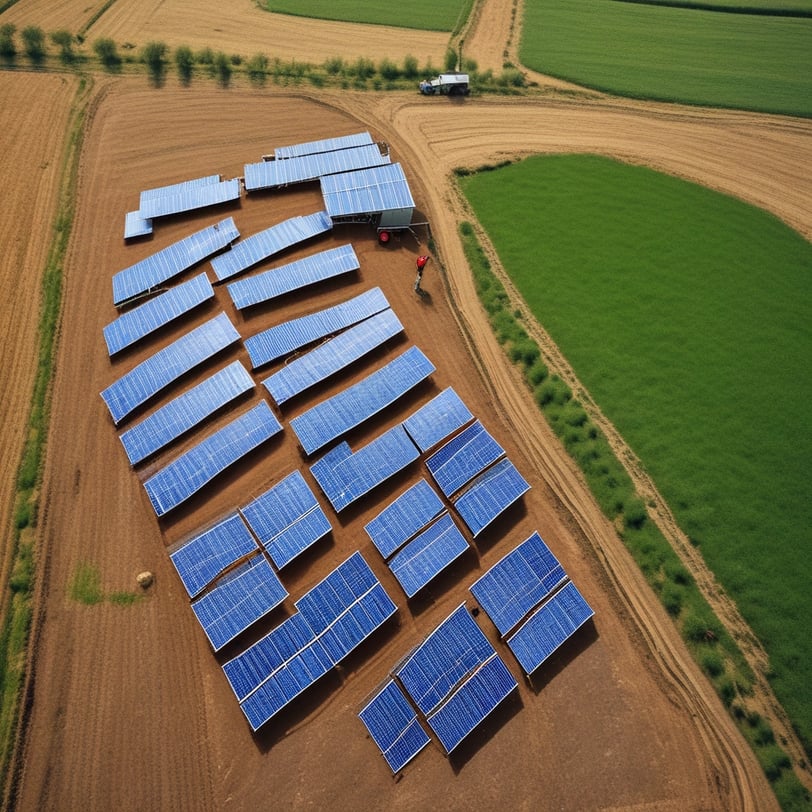Boosting Yields and Saving Money: The Benefits of Agrivoltaic Systems for Farmers
How Farmers Can Boost Yields and Save Money Using Agrivoltaic Systems
RENEWABLESOLAR ENERGY
Marius
1/7/20254 min read


Understanding Agrivoltaic Systems
Agrivoltaic systems represent a multifaceted approach that integrates agriculture and photovoltaic technology, effectively utilizing land for both food production and solar energy generation. This dual-use strategy not only promotes productivity but also addresses the urgent need for renewable energy sources. At the core of agrivoltaic systems are solar panels that harness sunlight and convert it into electricity while coexisting with agricultural crops. This integration ensures that farming activities remain viable alongside energy generation.
The fundamental components of an agrivoltaic system include solar panels, mounting structures, and the crops cultivated beneath or around them. The mounting structures are designed to hold solar panels at a height and angle that maximizes solar exposure while allowing sufficient sunlight to reach the crops. Depending on geographical orientation and specific farming goals, various configurations can be adopted, such as horizontal rows of panels or vertical placements that permit increased airflow and light penetration. Furthermore, the types of crops selected can be adapted to the specific climate and soil conditions, creating a symbiotic relationship between the crops and the solar technology.
Beyond the agricultural benefits, agrivoltaic systems provide significant environmental advantages. By utilizing existing farmland for solar energy production, these systems help mitigate land competition between agricultural and energy generation sectors. This integration leads to improved land use efficiency and helps to reduce greenhouse gas emissions associated with conventional energy sources. Additionally, creating shaded areas through solar panel installations can lower soil temperatures, potentially enhancing plant resilience and conserving water resources. Overall, agrivoltaic systems exemplify a sustainable farming practice that not only addresses food security but also promotes renewable energy generation, marking a significant step forward in agricultural innovation.
The Economic Advantages of Agrivoltaic Systems
Agrivoltaic systems represent a transformative approach for farmers looking to maximize their operational efficiency while simultaneously cutting costs. One of the most significant economic benefits is the reduction in energy expenses. By integrating solar panels with agricultural land, farmers can generate their own electricity, effectively decreasing reliance on conventional energy sources. This can be particularly advantageous in regions with high electricity costs, where self-generated power can lead to substantial savings over time.
In addition to lowering operational costs, agrivoltaic systems open up new avenues for income generation. Farmers can sell excess energy produced by their solar installations back to the grid, providing a supplementary income stream. This dual-use of land ensures that farmers not only cultivate crops but also benefit financially from renewable energy production. Furthermore, as renewable energy becomes more integral to the broader economy, the resale value of properties equipped with solar capabilities is on the rise, potentially increasing the overall property value.
Funding opportunities are also increasingly available for farmers opting for agrivoltaic technologies. Various grants, subsidies, and incentives, such as the USDA's Rural Energy for America Program, aim to alleviate the initial financial burden associated with solar panel installation and maintenance. These programs encourage sustainable practices while assisting farmers in making the transition to renewable energy.
Real-world examples showcase these economic advantages. For instance, a farm in California successfully adopted an agrivoltaic system that not only reduced its energy costs by over 40% but also generated an additional revenue of $20,000 a year from solar energy sales. Such case studies underline the potential of agrivoltaic systems to transform farming practices economically while also contributing to broader sustainability goals.
Enhancing Crop Yields with Solar Integration
Agrivoltaic systems, which combine agriculture and solar power generation, have emerged as a key innovation in sustainable farming practices, offering a multitude of benefits that can lead to improved crop yields. One of the primary advantages of this system is the creation of a microclimate favorable for plant development. The installation of solar panels can provide partial shade, which reduces soil evaporation rates. Consequently, this results in more efficient water usage and healthier plants, as roots can access the moisture they need without competing with excessive evaporation.
Furthermore, agrivoltaics enable farmers to cultivate agricultural land without incurring significant additional resource expenditures. By utilizing the same plots for both crop production and solar energy generation, a dual-use model is established that maximizes land efficiency. This approach not only allows for the potential cultivation of multiple crops but also mitigates the risk associated with monoculture practices. Various studies show that diversifying crops under agrivoltaic systems can lead to healthier soil ecosystems, which supports enhanced biodiversity and, in turn, improves overall agricultural productivity.
Moreover, farmer testimonials highlight the effectiveness of agrivoltaics. For instance, a farmer who integrated solar panels into their vineyard reported a 20% increase in grape yields while also generating substantial income from the energy produced. A comprehensive review of data demonstrates that crop yields can improve by as much as 30% under the shade of solar panels compared to traditional full-sun environments. This clearly illustrates the potential of agrivoltaic systems to transform agricultural practices, making them not only more productive but also more sustainable. The integration of solar technology in farming facilities represents a promising pathway towards enhancing crop yields while conserving vital resources.
Challenges and Considerations for Farmers
While agrivoltaic systems present a unique opportunity for farmers to enhance productivity and reduce costs, several challenges and considerations must be addressed before implementation. One of the primary barriers is the initial investment cost. Establishing a solar energy system, especially an integrated agrivoltaic design, necessitates substantial financial resources. Farmers often need to evaluate whether the long-term savings on energy bills and improved crop yields will offset these upfront expenses. Financing options, grants, or subsidies may be available to alleviate some of this burden.
Land use conflicts also pose significant challenges. In many agricultural settings, land is already at a premium, and converting parts of it for solar panel installation could lead to competition for space. Farmers must carefully analyze land usage, ensuring that solar panels do not displace valuable cropland or negatively influence the surrounding ecosystems. A well-thought-out site selection process, focusing on marginal lands or underutilized spaces, can mitigate this conflict.
Maintaining agrivoltaic systems alongside ongoing agricultural production can be complex. Farmers must establish practices that accommodate both crop cultivation and solar panel upkeep. This includes regular maintenance of the solar infrastructure—cleaning panels, checking electrical connections, and ensuring that the system operates efficiently. Additionally, considerations regarding shading effects on crops must be incorporated into field designs and planting strategies, necessitating cooperation with agronomy experts.
Regulatory hurdles can complicate the transition to agrivoltaic systems. Local zoning laws, permitting processes, and compliance with environmental regulations may require extensive research and adaptation of proposed systems. Engaging with local agricultural extension services or solar industry experts can provide valuable insights into navigating these regulatory landscapes.
In conclusion, while the shift to agrivoltaic systems is fraught with challenges, careful planning and strategic management can lead to successful outcomes that benefit farmers in both environmental and financial aspects.
We use the best automation tools combined with cutting-edge software platforms and multichannel digital marketing strategies to drive your growth.
💖 Give Us Some Love! 💖
Copyright © 2024-2025 - Devaland Marketing Agency (DEVALAND MARKETING S.R.L.). All Rights Reserved.
We improve our products and advertising by using Microsoft Clarity to see how you use our website. By using our site, you agree that we and Microsoft can collect and use this data. Our Privacy Policy has more details.
Sitemap.xml
Company Legal Informations:
DEVALAND MARKETING S.R.L.
Romanian Fiscal Registration Code (C.I.F. / C.U.I.) - VAT Code: RO50841395
Date of Incorporation: November 07, 2024
VAT Registered: February 01, 2025
Special European Union Intra-Community VAT Code (EU VAT Code): RO51050828
VIES VAT Code Validation: https://ec.europa.eu/taxation_customs/vies/#/vat-validation
Trade Registry Unique European Union ID Code (EUID): ROONRC.J2024039063003
Trade Registry Romanian ID Code: J2024039063003
Business Address - Fiscal Registered Office:
Santandrei 13, Simeria 335903,
Hunedoara County, Transylvania, ROMANIA
Banking info:
IBAN code (EURO): RO11BTRLEURCRT0690462601
IBAN code (USD): RO15BTRLUSDCRT0690462601
IBAN code (RON): RO61BTRLRONCRT0690462601
Transylvania Bank, Deva Branch
SWIFT Code: BTRLRO22
PayPal Business Account: office@devaland.com
Revolut Business Account: On request
Stripe Business Account: Automation
CAEN Rev.3 code: 7311 - Activități ale agențiilor de publicitate
CAEN Rev.3 code: 7311 - Advertising Agencies
DEVALAND
MARKETING AGENCY
Slack: @devaland
Signal: @Marius13.13
Telegram: t.me/Devaland13
Skype: devaland
Contact Us:
USA Phone: +1 (620) 622-9695
Office Cell Phone: +40 (721) 269 312
Dubai Phone (Idriss): +1 (251) 930 6553
WhatsApp 1: +40 (721) 269 312
WhatsApp 2: +40 (740) 062 622
Email Office: office@devaland.com
Email Dubai: idriss@devaland.net
Email2: devaland@gmail.com
Marius Andronie
Manager / CEO
Mobile: +40 (721) 269 312
Email: office@devaland.com
Idriss, Dubai Office
COO / Chief Operating Officer
Mobile: +1 (251) 930 6553
Email: idriss@devaland.net











